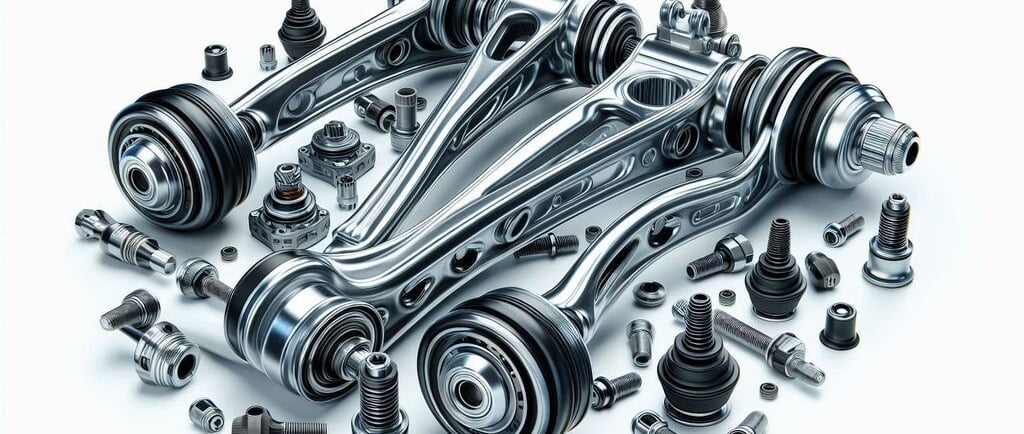Control Arms
If you’ve ever driven on a rough road or taken a sharp corner, you know how important handling and stability are to the safety and comfort of your ride.
SUSPENSION PARTS
11/14/20244 min read


Control Arms: Understanding This Essential Part of Your Suspension System
If you’ve ever driven on a rough road or taken a sharp corner, you know how important handling and stability are to the safety and comfort of your ride. Control arms are one of the critical components that contribute to this. In this article, we’ll dive into what control arms are, why they’re important, the types available, and how to identify issues before they affect your drive.
What are Control Arms?
Control arms, also known as A-arms or wishbones, are key parts of your vehicle’s suspension system. They connect the wheels to the car’s frame, allowing them to move up and down independently from the rest of the vehicle. This independent movement is crucial in handling rough terrains, providing a smoother ride, and keeping the vehicle stable.
Key Functions of Control Arms:
Support and Stability: Control arms help manage the wheels’ motion, stabilizing the vehicle and improving handling.
Wheel Alignment: Control arms contribute to keeping the wheels aligned and connected to the steering, which is essential for a balanced ride.
Shock Absorption: Working with the suspension system, control arms absorb shocks, reducing the impact felt inside the car.
Types of Control Arms
Different types of control arms are used depending on the vehicle design and suspension system. Let’s look at the most common types:
1. Upper and Lower Control Arms
In vehicles with double-wishbone suspension systems, there are two control arms – one on top (upper control arm) and one on the bottom (lower control arm). This setup provides enhanced stability and control, especially in heavy-duty or high-performance vehicles.
2. Single Control Arm
Some vehicles, particularly those with MacPherson strut suspensions, have only one control arm per wheel. This design is more compact and lighter, making it popular in many modern sedans and compact cars.
3. Trailing Arms
Trailing arms are another form of control arm that is typically used in the rear suspension. They help keep the rear wheels in place and manage the vehicle's movement along the length of the car.
Each type of control arm serves a unique purpose, tailored to different suspension systems and vehicle designs. But regardless of type, they all play a key role in handling and stability.
Signs Your Control Arms Might Need Attention
Control arms, like any other car part, can wear down over time. Recognizing the signs of a worn control arm early can prevent further suspension issues and keep your ride smooth.
1. Clunking Noise
One of the most common signs of a failing control arm is a clunking noise. This noise often becomes noticeable when driving over bumps or potholes and can indicate loose or damaged control arm bushings.
2. Vibrations in the Steering Wheel
If the control arm bushings or ball joints are worn out, you may feel vibrations in the steering wheel, especially at high speeds. This is a warning sign that your control arms may need inspection or replacement.
3. Uneven Tire Wear
When control arms start to wear out, they can affect your vehicle’s alignment, causing uneven tire wear. Checking for uneven wear patterns on your tires can help you spot suspension issues early.
4. Poor Handling or Pulling to One Side
If you notice that your vehicle pulls to one side or that handling feels less stable, your control arms may not be properly supporting the wheels. This could lead to safety risks if left unaddressed.
Replacing and Maintaining Control Arms
Like most car components, control arms require periodic inspection and maintenance. In some cases, individual parts like bushings or ball joints may need to be replaced, while other times the entire control arm may need replacement.
Steps for Control Arm Maintenance:
Regular Inspections: Check for wear, particularly in the bushings and ball joints, which tend to wear out first.
Alignment Checks: Ensuring your wheels are properly aligned can prolong the lifespan of your control arms and improve your car’s handling.
Replace Worn Parts: If your control arms show signs of wear or damage, replace the components before they lead to other issues in your suspension system.
Cost of Control Arm Replacement
Replacement costs for control arms vary depending on the type of vehicle and the specific part. Generally, replacing a single control arm can range from $100 to $500 per part, plus labor costs. Ensuring regular inspections can help you catch issues early, possibly avoiding a full replacement.
Choosing Control Arms: OEM vs. Aftermarket
When it comes time to replace control arms, you may wonder whether to choose OEM (Original Equipment Manufacturer) or aftermarket parts. Here’s a quick comparison:
OEM Parts: These parts are made by the original manufacturer and are a direct match to the existing component in your car. They are usually more expensive but offer reliability and a perfect fit.
Aftermarket Parts: Aftermarket control arms are often cheaper and come from third-party manufacturers. While some are high quality, others may lack the durability and precise fit of OEM parts.
Choosing between OEM and aftermarket control arms depends on your budget, driving needs, and the importance you place on reliability and fit.
Conclusion: Control Arms are Vital for a Smooth, Stable Ride
Control arms may not be as well-known as other car parts, but they’re essential for maintaining control, stability, and comfort in your vehicle. Keeping your control arms in good condition and recognizing early signs of wear can help you avoid costly repairs and ensure a smooth ride.



